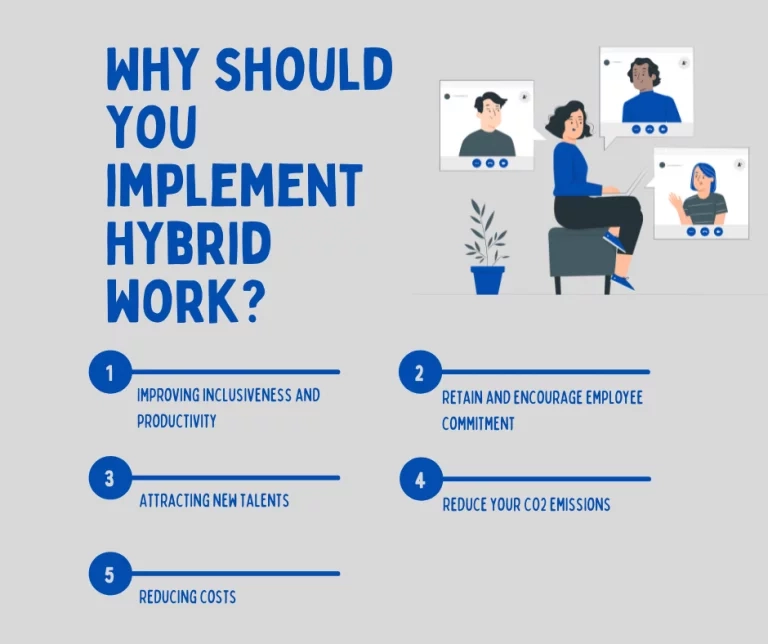
The recent health crisis has changed the way companies are organized and highlighted new ways of working. The use of remote work appeared as an essential way to reduce the risks of contamination in companies, and even if the return to the office has already been undertaken by a large part of companies, it is obvious today that we will not return to exactly the same way of working as before the crisis. Hybrid work, a mix of remote and face-to-face work, will become more and more the norm for companies in many industries. In this post, we explore the pros and cons of hybrid work, as well as some of the keys to successfully implementing this new way of working.
1. Hybrid work: a successful way to work
The health crisis related to the Covid-19 pandemic has changed the way companies are organized. The sudden arrival of the coronavirus and the rapid growth of infections forced companies around the world to set up a work organization that reduced face-to-face work as much as possible and favored remote work. During this period, most companies implemented a wide range of collaboration tools to keep their operations running as efficiently as possible.
The widespread use of remote work has deeply changed our practices, but it has also brought to light a significant number of benefits related to this new way of working.
Many studies have looked at these new practices and have identified several factors that would lead companies to adopt a hybrid work model, once the current health crisis is over:
- According to a McKinsey study, a majority of executives in various industries believe they have experienced improvements in inclusiveness, productivity and customer satisfaction
- The Work Trend Index study, conducted by Edelman Data x Intelligence, found that employees are demanding more flexibility at work: 73% of employees say they might leave the company if remote work options are not offered.
- Finally, some studies have also looked at the positive impacts of remote working on reducing our CO2 emissions. According to ADEME (The French Agency for Ecological Transition), the generalization of remote work would allow us to reduce the volume of our travel by 69%. This would represent nearly 3.3 million fewer trips per day, or at least a reduction in our CO2 emissions of about 3,300 tons at peak hours on a weekday.
- According to a study by Atlassian and Paper Giant, 62% of French workers prefer hybrid work, compared to 49% in the rest of the world. Hybrid work is very popular among the French.

Two years after the world abruptly shifted to the widespread adoption of remote work, workers and companies are trying to regain some sense of normality, improve work-life balance and reconnect with colleagues while keeping some of the benefits of remote work. Hybrid work therefore seems to be emerging in practice as a unique opportunity to rethink how we organize ourselves and the way we work.
To successfully implement a hybrid work mode, it is important to understand that it is not only about mixing office time with remote work time. Above all, it is about offering employees a flexible balance between work and private life. A well thought-out and anticipated implementation of a hybrid work model will allow companies to improve their productivity and encourage employee engagement.
2. The pros and cons of a hybrid work model
Hybrid work has both pros and cons that must be considered in order to successfully implement this type of organization.
a. Pros
Cost reduction

In a hybrid work model, it is very rare that all of the company’s employees are present in the office at the same time. The use of hybrid work allows companies to reduce their operating costs: rent, depreciation, heating, electricity, maintenance and cleaning. Even if there are trade-offs, such as the assumption of certain costs related to remote work (professional expenses, equipment, etc.), when it comes to assessing the results, hybrid work allows companies to make real savings.
Attract and retain talent

Workplace flexibility allows employees to balance their workload and improve their satisfaction. According to different studies on the topic, lack of flexibility is becoming a potential reason to switch to another company. Flexibility has even become a competitive advantage for companies in the context of a pressured job market. Hybrid work is one of those forms of flexibility that can convince your employees to stay and be satisfied with their working conditions.
Hybrid work can also attract people from far away areas of the country, or talent looking for companies that are flexible in their work organization.
Improving productivity

Prior to the pandemic, many companies were sceptical about remote working, particularly in terms of employee productivity. With the forced generalization of teleworking, many of these companies realized that it could have positive impacts on employee productivity. A hybrid work mode allows employees to better use and organize their time and to concentrate more when they have to perform tasks where it is essential not to be disturbed.
As we saw earlier, hybrid work also improves employee satisfaction, and it is clear that an employee who is satisfied with the work environment will be less stressed and work better.
b. Cons
More complex implementation of teamwork
Tasks that need to be accomplished in teams are easier to accomplish in the office, as employees can interact and share ideas in a much simpler and faster way. The lack of face-to-face interaction can also diminish the sense of belonging to the company culture. However, collaboration tools can help improve teamwork in a hybrid work environment.
Lack of equity among employees
Not all employees choose to work in a hybrid work environment; some of them may prefer to work face-to-face and be more present in the office than some of their colleagues. This situation can create inequalities in the employee experience and make some employees feel excluded or lonely. The success of hybrid work will depend on your company’s ability to provide an equitable experience of collaboration.
Organizational challenges
Hybrid work implies the need to organize the presence of employees in the office. Poor organization can lead to difficulties with offices and meeting rooms availability, as well as communication problems when it comes to organizing time to attend meetings that facilitate exchanges between teams.
Security concerns
With the rise of hybrid work, cyber attacks are on the rise. According to a study by Tanium in 2020, 90% of companies have experienced cyberattacks, risks that companies should take seriously. These risks are further heightened, when you consider that corporate employees are increasingly using cloud solutions and connecting to corporate networks with devices or software that are not certified or authorized by the company.
3. The keys to successful implementation of hybrid work
Work organization
The organization of hybrid work implies organizing the flexibility offered to employees. Hybrid work implies the coexistence of office-based and remote employees, alternating between face-to-face and remote time for some employees, a degree of flexibility in terms of mandatory days of presence, differences in working hours, etc. The organization of hybrid work is not only limited to the management of schedules. It is also and above all a question of setting up an organization that facilitates communication between all the parties involved, of promoting tools that encourage planning and teamwork, of defining the tasks that can be done from home and those that require being in the office, and of ensuring that collaboration is encouraged regardless of the context, the place of work or the role in the company.
New ways to manage and communicate
Hybrid work implies the implementation of new forms of management that are much less vertical and that take into account the wishes of employees in an efficient way. To successfully implement hybrid work, companies can rely on communication and collaboration solutions, but software solutions alone are not enough to transform the work model in a sustainable and successful way. This change must be supported by transparent communication at all levels and by the creation of a corporate culture that puts the human factor at the center, promotes proximity, encourages a sense of belonging to the company and is based on a culture of trust.
Videoconferencing: an essential tool for hybrid work
Digital tools are becoming more and more common in companies, especially collaboration platforms and tools: instant messaging tools, video conferencing platforms, office and workspace reservation tools, shared calendars, project monitoring and management tools, etc. All of these tools must allow teams to come together regardless of where they work.
Among these tools, videoconferencing has emerged as the most important facilitator of enterprise collaboration. It helps maintain communication between teams and improve understanding. Videoconferencing has now found its place in companies thanks to the rich interactions it allows and the ease of its implementation. Today, in large companies, 71% of employees say they use video conferencing on a daily basis. As far as team spirit is concerned, videoconferencing is much more effective than communication channels such as the telephone, email or chat. The use of videoconference can go beyond internal collaboration. It can also facilitate exchanges with customers or external providers while limiting travel and creating stronger links than by phone.

In order to avoid security risks related to the use of videoconferencing solutions, it is important to put in place best practices to ensure maximum security for videoconferencing sessions in the company. This includes:
- Choosing a solution that correctly manages the use of personal data
- The evaluation of the editor’s profile and the location of its servers
- The use of a solution that secures access to the videoconference through strong authentication modes (login and password, double authentication for sensitive meetings…)
- Secure file sharing
- The choice of an adapted hosting mode: even if SaaS hosting is the most common, for some companies, it may be wise to use a videoconferencing solution allowing hosting in its own infrastructure
- Employee awareness of security risks and best practices for videoconferencing sessions
- Vigilance during videoconference sessions in public spaces (trains, coworking spaces, airports, train stations, etc.)
Even if hybrid work represents new challenges for companies, it also implies advantages. To successfully implement it, collaborative tools such as videoconferencing play an important role. Contact our team to find out how Apizee’s video conferencing solutions can help you deliver an optimal collaboration experience and facilitate hybrid work without compromising on the level of security required for corporate use.
I would like to be called back
We also recommend:
- Benefits of WebRTC solutions for video conferencing and video communications
- Video conferencing solutions: security comes first

![[CX Industry Voices] Interview with Claire Boscq](/scripts/files/685be577407c05.79748508/claire-boscq.png)

![[CX Industry Voices] Interview with Simon Macklin](/scripts/files/6853c1e544e284.60938932/simon-macklin.png)